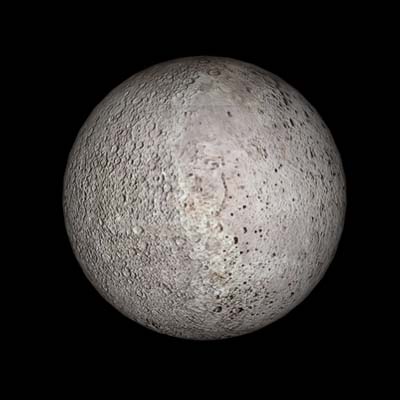Eris
Eris is named for the ancient Greek goddess of discord and strife.
It takes icy Eris 557 Earth years to complete a single orbit around our sun. The plane of Eris' orbit is well out of the plane of the solar system's planets and extends far beyond the Kuiper Belt, a zone of icy debris beyond the orbit of Neptune.
The dwarf planet is often so far from the sun that its atmosphere collapses and freezes on the surface in an icy glaze. The coating gleams brightly, reflecting as much sunlight as freshly fallen snow. Scientists believe surface temperatures to vary from about -359 degrees Fahrenheit (-217 degrees Celsius) to -405 degrees Fahrenheit (-243 degrees Celsius). The thin atmosphere will thaw in hundreds of years as Eris gets closer to the sun, revealing a rocky surface scientists believe is similar to Pluto.
Eris first appeared to be larger than Pluto, a discovery that triggered debate in the scientific community and eventually led to the International Astronomical Union's decision in 2006 to clarify the definition of a planet. Recent observations indicate Eris may actually be a little smaller than Pluto. Pluto, Eris and other similar objects are now classified as dwarf planets. They also are called plutoids in recognition of Pluto's special place in our history.
Since Eris is too small and too far to see clearly, scientists used its tiny moon Dysnomia to measure it. Dysnomia has a nearly circular orbit lasting about 16 days. All the asteroids in the asteroid belt would easily fit inside Eris. However, Eris, like Pluto, is still smaller than the Earth's Moon.
Eris was first spotted in 2003 during a Palomar Observatory survey of the outer solar system by Mike Brown, a professor of planetary astronomy at the California Institute of Technology; Chad Trujillo of the Gemini Observatory; and David Rabinowitz of Yale University. The discovery was confirmed in January 2005, and was submitted as a possible 10th planet of our solar system since it was the first object in the Kuiper Belt found to be bigger than Pluto.
Originally designated 2003 UB313 (and nicknamed for the television warrior Xena by its discovery team), Eris is named for the ancient Greek goddess of discord and strife. The name fits since Eris remains at the center of a scientific debate about the definition of a planet.
"Eris is the Greek goddess of discord and strife," said Mike Brown, a member of the discovery team. "She stirs up jealousy and envy to cause fighting and anger among men. At the wedding of Peleus and Thetis, all the gods were invited with the exception of Eris, and, enraged at her exclusion, she spitefully caused a quarrel among the goddesses that led to the Trojan War.
"She's quite a fun goddess, really," Brown said. "And, for the Xena fans out there who are sad to see the name go, Eris appeared in her Latin version of Discordia as a recurring character on 'Xena: Warrior Princess.'"
Eris' moon, Dysnomia, is named after Eris' daughter who is the demon goddess of lawlessness.



